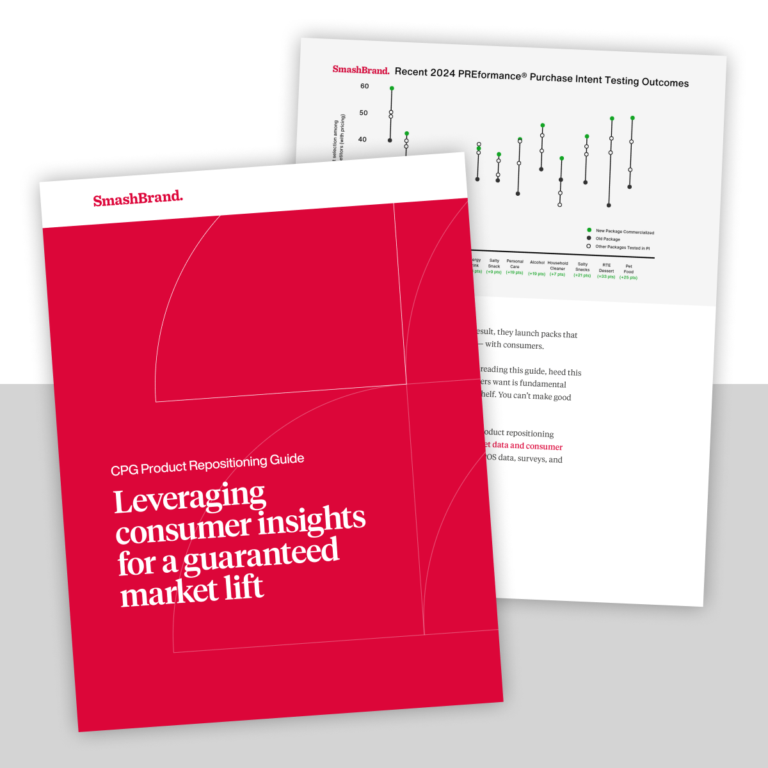Launching a new brand or rebranding can be risky. How can you be sure that consumers will like the “new you” or whether it’ll end up driving people away? Some businesses have lost hundreds of millions of dollars on ill-advised rebranding decisions.
Consumer testing is an important part of any brand strategy. You need to talk to consumers about your branding decisions, and you can make alterations to your strategy or messaging based on their feedback. This will save you a lot of headaches and make sure your brand strategy and messaging will be effective.
What Is Consumer Testing?
There are a lot of “what ifs” that come along with creating a brand. Will your color choices resonate, does your logo look appealing, is your packaging working hard?, etc.? Do you know who has these answers? Your target consumers.
Consumer testing in its simplest form is asking consumers if they like potential branding decisions. If they say yes, you move on to the next step of the process. If they say no, you gain more insight to make changes based on their feedback until it’s performing better than the competition. After a few rounds of testing, you should have a good idea of what consumers like, along with a powerful branding strategy that will turn your target demographic into a tribe of loyal followers.
Is Consumer Testing Really Important?
In short, yes. Consumer testing can help you make sure your brand strategy and messaging is consistent with your business and resonates well with potential customers.
There are several major benefits to consumer testing:
- Gather real data to back up your brand strategy.
- Identify areas of improvement.
- Learn how different demographics react to your choices.
It can also save you millions of dollars on poor marketing decisions. But don’t just take our word for it. Check out what happens when a company skips consumer testing:
In 2010, Gap decided to initiate a quick rebrand before the holiday season, swapping out their iconic blue and white logo for something more modern. They didn’t run consumer tests or ask any questions. Of course, the Gap logo is well known around the world, and the company faced immense backlash. They decided to play the “just kidding” card and reverted to their old, tried-and-true logo.
The whole blunder cost Gap an estimated $100 million. If they had simply performed some brand testing, they would have realized that updating an iconic logo was a poor move.
Four Consumer Tests to Judge Brand Strategy and Messaging
Before launching a new brand or rebrand, it’s important to perform your due diligence and make sure your changes will have a positive impact. Here are six consumer tests that will get your brand strategy honed to perfection.
1. Attitude and Usage Survey
An attitude and usage survey is a simple list of questions that provides insight into how consumers view your brand and products. It can also help you find links between customer opinions and how they use your products.
For this consumer test, ask questions like:
- How familiar are you with this product?
- Which of these competing brands have you used?
- How did you first hear about this product?
- How would you rate the quality of this product?
- What would you most like to change about this product?
The answers will give you a feel for how consumers perceive your brand and products.
Attitude and usage surveys are typically done online. Participants can fill in the survey online or with their mobile devices.
2. Focus Groups
After you understand your target demographic and have some ideas to revamp your brand strategy or messaging, you can use focus groups to learn what people really think of your changes.
Assemble at least three groups of eight to ten people to start. Make sure they’re in your target demographic (or a demographic you’d like to break into). Present the brand changes you’d like to make and ask the group what they think of the changes. Use the feedback to adjust your brand strategy or messaging. Then try again!
3. Message Testing
Message testing is testing the clarity of your message, whether it’s in line with your brand’s image, and whether it engages consumers. Without it, you might accidentally tell customers something you don’t intend to, which will lead to poor sales.
A great example of the importance of message testing comes from Coors. Coors has always brewed its beer with delicious, high-quality Rocky Mountain spring water. During the bottled water boom of the 1990s, they decided to grab a piece of the action and started bottling their own sparkling water with the Coors logo front-and-center on the bottles.
Well, people saw the Coors logo on the bottle and figured it was alcoholic sparkling water. Once they found out it was just regular spring water, sales tanked, and Coors had to leave the bottled water game.
If they had performed adequate message testing, they would have realized that having the Coors logo on the front was telling consumers there was alcohol in the bottle, which is a message they didn’t mean to convey.
4. Package Testing
Packaging makes your products stand out on the shelves. Without optimized packaging, your products will fade into the background and collect dust. Package testing lets a group of people interact with your packaging and give you feedback.
With package testing, you can learn a lot about how your packaging influences buyers:
- Design concepts
- Purchase intent
- Stand Out
- Brand Recall
After the focus group takes a thorough look at your packaging, ask them to rate various factors like design appeal, uniqueness, ease of use, etc. Once you have the answers, use the feedback to alter your design to make it even more effective.
Strengthen Brand Strategy and Messaging with Consumer Testing
There are many variables that go into a successful brand strategy or messaging update. The only way to know if consumers will actually like the changes is by asking them.
Consumer testing allows you to go straight to the consumers and ask them what they think of your message, branding, packaging, or anything else that could affect sales. Armed with real consumer feedback, you can optimize your products to succeed on the shelves.
Learn how your products fit into the market with SmashBrand’s package design testing services. We’ll perform all the necessary testing to ensure your packaging is ready to hit the stores. Contact us to get started.
Subscribe to
Nice Package.
A monthly newsletter that unpacks a critical topic in the FMCG & CPG industry.
Free Resource.

CPG product repositioning guide.
Explore the five undeniable signs your CPG product needs repositioning along with strategies for leveraging consumer insights for a guaranteed market lift.
Learn More About CPG product repositioning guide.